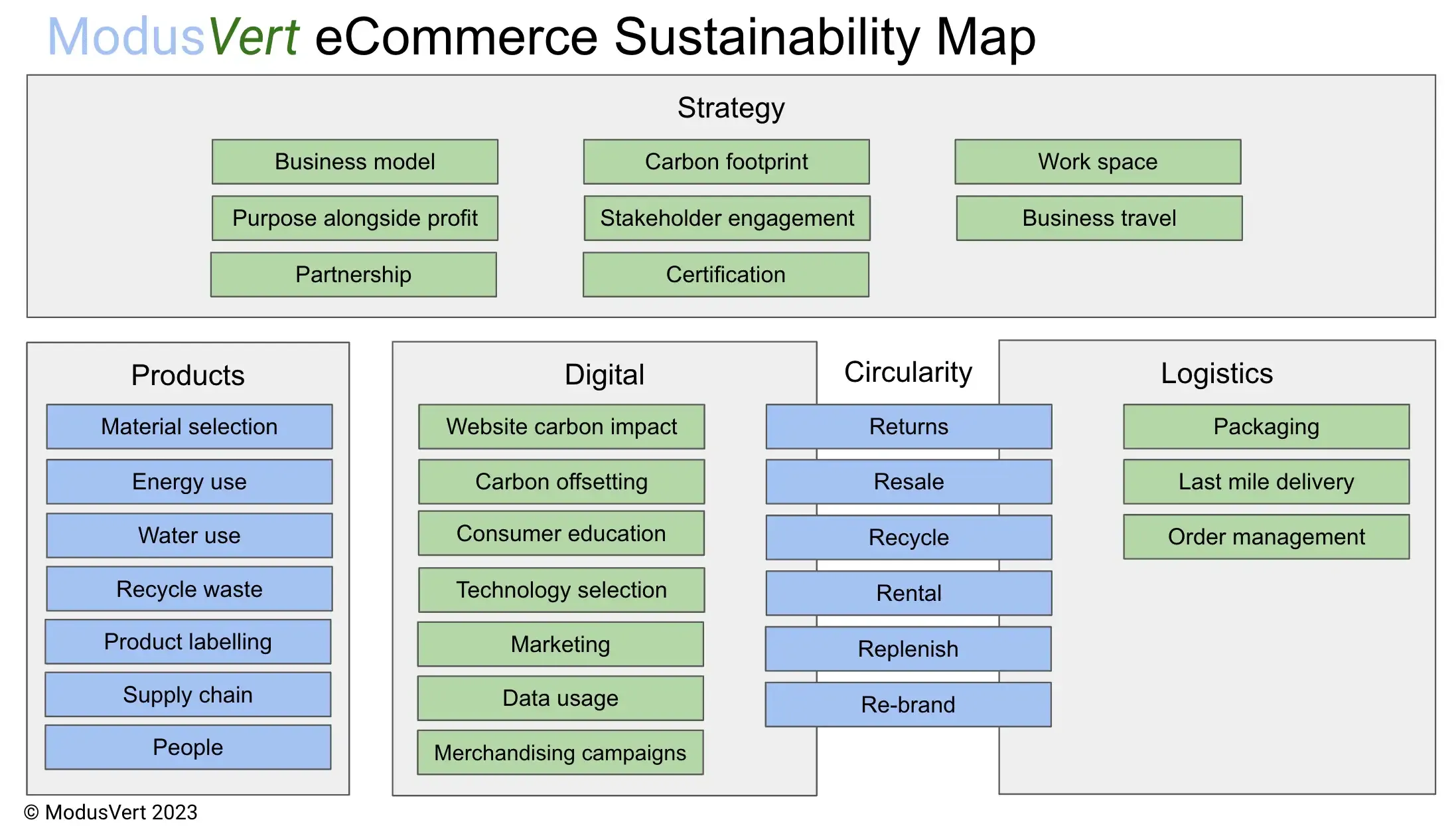❓Sustainable eCommerce - an oxymoron?
eCommerce has experienced rapid growth in recent years and particularly it has accelerated during the COVID pandemic. This pace of change is expected to continue with estimates of eCommerce penetration doubling in the next decade. The next decade is the key decade for making substantial changes to meet our global 2030 carbon targets. Clearly, eCommerce businesses must make changes to become more sustainable as they continue to grow. However, sustainability is complex and it’s difficult to know where to start.
The sustainability map
ModusVert has created a sustainability map which represents the different aspects of sustainability - around thirty themes spread across five key areas:
- Defining your business strategy
- Sourcing or manufacturing your products
- Considering your digital presence
- Adopting product circularity
- Optimising your logistics activities

Defining your business strategy
When thinking about your journey to becoming a more sustainable business, a clear sustainability strategy is essential. It’s important to first understand the current state of your business, so a carbon footprint analysis may be useful at this stage. You can then think about adapting your business model towards sustainability and how your stakeholders and partners can play a part.
You may also want to consider working towards one of the many different forms of certification which are now available, such as attaining b-corporation status. You may then want to set targets - This might be reducing your carbon emission each quarter, or aiming for net zero by a particular year. Defining and setting targets will help you to progress on your journey. Carbon offsets may also play a part here but we feel that they should be considered after looking at all other ways to reduce impact.
Sourcing or manufacturing your products
The second area to focus on is your products and how you either source or manufacture them. There are many factors here, for example, when selecting materials you may want to consider recycled materials or materials which are easier to recycle at the end of their lifecycle. You should look to design processes to reduce pre-consumer waste and look to recycle the waste which is created.
You should think about designing products for a longer useful life and may want to consider product labelling to help consumers understand the journey the product has gone through to reach them. You should look look to reduce water and energy use during the manufacturing process.
Considering your digital presence
We often think about the digital sphere as creating less of an environmental impact but in fact taking action on the digital side of your business can also help to reduce the impact your business has on the environment. Starting with your eCommerce website you can take actions to reduce the carbon weight of your website - this will also improve the performance of your site. You can also host your site on a company using renewable energy.
Through your website you can also encourage consumers to make more careful buying decisions and promote positive consumption. For example, free delivery and next-day delivery options being made more readily available take a significant toll on the environment in a multitude of ways. Making changes on your website, such as offering a ‘green’ delivery option and being more thoughtful around marketing campaigns can all make a difference.
Optimising Logistics
For many businesses a majority of their carbon emissions come from getting products to consumers. There’s a lot that you can do here from looking at recycled or reusable packaging materials, reducing the size of packaging and amount of material needed to securely ship a product.
Further, there are many things you can do to reduce the impact of the last mile delivery of your products. You could incentivise customers to make greener decisions in regards to shopping. For example, you could encourage them to collect parcels from local shops/distribution centres, or, on your website, you could reduce free delivery options. Other options include using electric or pedal power for delivery and using local fulfilment centres.
Adopting product circularity
The final step to consider in developing your sustainability roadmap is increasing product circularity which we see as spanning the digital and logistics domains. Making your business more circular is a pertinent way to significantly reduce its impact.
You can help customers to select the right product and size first time, and therefore reduce returns, by providing detailed sizing information and consumer reviews as well using AR to let consumers virtually “try on” a product. You could offer the ability for consumers to resell their products to another shopper - this increases the lifecycle of a product as well as making your products more accessible to a new class of value focused consumers.
You could also offer shoppers a way to easily repair products or where that’s not possible recycle products at the end of their useful life.
As you can see there are many different potential ways to make your eCommerce business more sustainable.
ModusVert can help you navigate this space - get in touch for a free discovery call.